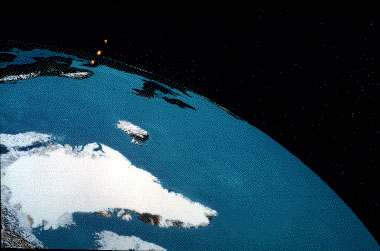|
The confirmation of the existence of atmospheric holes with the Polar cameras is demonstrated by the ultraviolet image shown in Figure 6 [below]. This atmospheric hole is positioned above Poland and was recorded on April 6, 1996. It is remarkable that the rate at which these atmospheric holes occur in the atmosphere is very similar to that previously observed with Dynamics Explorer 1, even though the cameras were greatly different.
The second independent confirmation was also provided by the camera for ultraviolet wavelengths. A few of the small comets were disrupted at much higher altitudes than for the vast majority of comets impacting the atmosphere. For those which were bursting at the higher altitudes, trails of bright glows from atomic oxygen were clearly observed. An example of such a trail is shown in Figure 7 [below].
This picture was taken on September 26, 1996. The bright trail of the gases from the disrupted comets has been superposed upon a map of Earth generated by a commercial computer program in order to provide perspective as to the view seen by the Polar camera. The trail moves across the Atlantic Ocean and ends above Eastern Germany. Such photographs never had been taken by any previous spacecraft. Note that the images in both Figures 6 and 7 [above] show atmospheric impacts at locations other than the North American continent. Because of the emotional reactions of a group of scientists in the United States to the amazing set of new images we had decided that it was best to show impacts in other locations for the first press releases in order to ameliorate the situation. Indeed cometary trails above the Northern Hemisphere are observed. An example of a trail captured in a photograph on September 28, 1996 above San Diego, California is shown in Figure 8 [below]. Such pictures provide undeniable evidence that a new class of objects has been discovered in the vicinity of Earth.
Finally, as a third independent verification of the existence of the
small comets another of the three cameras was used to search for the
cometary water impacts into the atmosphere. These pictures were taken in
light that was nearer to the range of our eyesight but still a little too
far into the violet to see. However, this was a wavelength which is used
But there was a surprise awaiting us when we turned the cameras to view the small comets which were impacting the Earth's upper atmosphere. The light from the water fragments was dramatically seen in the sequences of three snapshots for each comet, one sequence of which is shown in Figure 10 [below]. The surprise was the absence of sodium and dust in these water clouds of the disrupted small comets. This provided the explanation for one puzzling aspect of the small comets, the absence of very bright trails during the atmospheric impacts. Sodium and dust provide bright impact glows, but water and its fragments are much dimmer. Thus the composition of the small comets is significantly different than that of the well-known large comets. It was rewarding to compute the amount of water vapor in the small comets from measurements of the brightness of the light emitted by the water fragments. The mass of water in a single comet was about 20 to 40 tons, and confirmed the result obtained independently from observations of atmospheric holes. Complete closure was obtained when the measured frequency of water trails such as that shown in Figure 10 was found to be very similar to the occurrence rate of atmospheric holes such as that displayed in Figure 6.
|



 frequently to monitor the well-known large comets. This light is emitted
as the Sun illuminates the fragments of cometary water vapor,
specifically the fragment produced when a hydrogen atom is stripped from
a water molecule. In order to calibrate our cameras on the Polar
spacecraft we pointed them toward Comet Hale-Bopp as it approached the
Sun. This was very exciting and instructive for us. Images in two
different colors of light are shown in Figure 9 [right]. The top picture
shows this large comet as seen in the light from the fragments of water
vapor as noted above. The bottom photograph is taken in the light emitted
by sodium and also light scattered from cometary dust. The sodium is to
be found in the remarkable thin trail at the top and the rest is due
to dust. Thus the Polar cameras were shown to be very capable of
detecting cometary lights.
frequently to monitor the well-known large comets. This light is emitted
as the Sun illuminates the fragments of cometary water vapor,
specifically the fragment produced when a hydrogen atom is stripped from
a water molecule. In order to calibrate our cameras on the Polar
spacecraft we pointed them toward Comet Hale-Bopp as it approached the
Sun. This was very exciting and instructive for us. Images in two
different colors of light are shown in Figure 9 [right]. The top picture
shows this large comet as seen in the light from the fragments of water
vapor as noted above. The bottom photograph is taken in the light emitted
by sodium and also light scattered from cometary dust. The sodium is to
be found in the remarkable thin trail at the top and the rest is due
to dust. Thus the Polar cameras were shown to be very capable of
detecting cometary lights.
